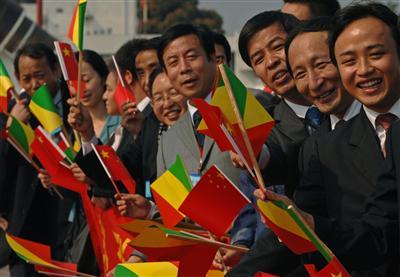
Commodity Flux and China’s Africa Strategy
Publication: China Brief Volume: 9 Issue: 2
By:

The commodity price decline has revealed to the Africans something of the nature of their friends. During the commodity price boom, China invested massively in Africa seeking to lock up as many raw materials as possible. Some in academia spoke confidently of China having a fifty or one hundred year strategy toward Africa. In practice, Chinese entrepreneurs have been the first to leave when the market turned since the global decline in commodity prices accelerated with the collapse of Lehman Brothers in September 2008. For instance, according to interviews the authors conducted in Congo, more than 60 Chinese mining companies have left the mineral rich Katanga the last two months, as cobalt and copper prices have tanked. Over 100 small Chinese operators are reported to have left Zambian mines for the same reason.
A similar retreat may be occurring at the strategic level. In 2007, it was announced that China would lend the Congo $5 billion to modernize its infrastructure and mining sector. Under a draft accord, Beijing earmarked the funds for major road and rail construction projects and for rehabilitation of Congo’s mining sector, while the repayment terms proposed included mining concessions and toll revenue deals to be given to Chinese companies. In simple terms it meant 13 million tons of copper for $5 billion—or (even at today’s depressed prices) $40 billion for twenty-times less [1]. The China-Congo deal, however, has gone very quiet as the copper price has plummeted. The market—not grand strategy—is the main Chinese motivation in Africa.
Africa and China
African countries have, on average, grown by five percent or more over the last few years. This remarkable turnaround from the low rates of growth of the previous 20 years has given some hope that many of the world’s poorest countries can finally start on the road to development and poverty alleviation. The growth resurgence in Africa has been due to the many difficult economic reforms that many countries have undertaken, including liberalizing the exchange rate and reducing inefficient state enterprises. Yet, growth in Africa has also been fuelled by the large increases in commodity prices over the last few years as most countries are dependent on the export of a few raw materials.
Africa is a new continental market for lesser-priced Chinese exports, while it is a major source of raw materials. China’s trade with Africa has dramatically increased from $11 billion in 2000 to $73 billion in 2007 [2]. As the price of commodities rose, China rapidly became the most assertive investor nation in Africa. By the start of 2008, over 800 Chinese state-owned enterprises were active on the continent, with Chinese firms investing more than $6 billion in Africa in 900 projects—notably in the natural resource sector [3].
Until recently, it appeared that Africa’s dependence on commodity export would not be an obstacle to growth In the middle of 2008, as oil surged past $140 per barrel, there were confident predictions of a commodity “supercycle” based on sustainable increases in demand from India and China that would keep not only petroleum but every other commodity at record high prices. In fact, commodities have crashed. Oil is now below $50 per barrel and other commodities have succumbed to the downward pressure. The benchmark copper price has fallen 65 percent since July and cobalt is now at approximately $16/lb down from $52 in March (Mining Weekly, December 16, 2008).
The sharp drop in commodity prices has many implications for Africa—and by extension its relations with China. First, growth is going to be massively slashed. Indeed, the price declines have been so sudden and so brutal that many African leaders, who believed that they were doing what the west recommended, suddenly find their economies to again be in tatters. For instance, in Zambia, a combination of bad political leadership, a failure to reinvest, and falling prices had seen copper production fall by the early 1990s to less than one-third of its 720,000 ton 1960s peak [4]. In 1991, the Zambians finally voted out the old party that had presided over decline and instituted a controversial program of privatization. Riding on the commodity boom, Zambia has enjoyed a five-year boom, with production rising to 600,000 tons [5]. Now, Zambian mines are closing as many are unable to produce at the current cost and unemployment is growing rapidly. The value of the local currency, the Kwacha, fell by three-quarters in just 45 days from the start of November 2008. It may not end here. As Zambia’s Finance Minister Situmbeko Musokotwane said: “I suspect there will be further knock-on effects, particularly among the sub-contractors to the mines.”
However, it is questionable whether Zambia, like others, even made full use of the boom. In response to the high prices Zambia introduced a ‘windfall tax’, the result being that some mines were forced to pay tax before they made any profit. The outcome: All new investments stopped, including those that would have given old mines a new lease, which may have mitigated the impact of the current price downturn. The windfall tax rates meant that as copper prices rose above $3 per pound triggering the tax, so the profitability of operations decreased. Unusually it became in companies’ financial interests to see prices decline to avoid such taxation.
A similar if more desperate story is underway in the neighboring Congo. Under former president Mobutu Sese Seko’s misrule, by the mid-1990s the annual per capita income of Congolese was, at $120, two-thirds less than before independence. The commodity boom helped Congo and at least Katanga province, where much of the mining is located, experience an uptick. However, Katanga is now in freefall as many of the mines are closing and may well take the rest of Congo with it. Indeed, the upsurge of violence in Eastern Congo may be due in part to the fact that rebels fighting the Congolese government are aware of the commodity price decline and are deliberately picking a fight against a government that they know has grown weaker.
While the Africans are understandably bitter about the sharp price decline in their export prices that seemingly began with the overbuilding of houses in Boca Raton, Florida, they are not without blame. The commodity boom produced something akin to the proverbial seven fat years for some African countries but there was very little effort to diversify production while the going was relatively good. In particular, the very old story of underinvestment in agriculture was repeated as Africans listened to those analysts who said that commodity prices would stay high forever. Now they are stuck with low prices for their exports and little else.
In the DRC, like Zambia, opportunistic policy and recalcitrant bureaucracy has not helped. In response to high prices the Congolese government initiated a ‘revisitation process’ early in 2007, questioning the tenure of all mines and forcing companies to reapply for licenses. Such uncertainty made raising capital more difficult. As a result, big long-term mining projects are now at risk. Indeed, such greed may have ensured the DRC has largely missed out on the metal price bubble.
The effects of such avarice have been exacerbated by the nature of the DRC’s bureaucracy. This is one hangover from former president Mobutu Sese Seko’s 35 years in office when everyone was left to fend for themselves, using their office to frustrate progress until paid. As one mining executive observed, “until the international community can somehow pay for salaries of the bureaucrats, I don’t believe things will change much.”
No doubt some African countries have benefited on balance from the commodity downturn, as food and fuel prices have fallen. Most African countries are, after all, net energy and food importers. Yet, the sudden price decline has proven again that African countries are not immune to the effects of the international financial crisis and that they must redouble efforts to reduce their dependence on raw material exports.
Despite the price declines, Africans in southern Africa that the authors speak to remain committed to competing in the international economy and driving their countries forward through better policies. Interestingly, government officials and businessmen in Africa never mention foreign aid as a particularly important driver for growth, despite the lavish attention that western media gives to actors, musicians, and others who continue to promote Africans as helpless victims who need ever-greater handouts. Today’s leaders in Africa know, especially in light of the commodity decline, that they have made mistakes but they also know that they will determine the fate of their countries. To do so, they will need a recipe of sound bureaucracy, and consistent policies attractive to investors. China, African leaders know, will be an important and growing presence in Africa. Yet, the price decline, and the subsequent Chinese response, will probably cause African leaders to recalibrate their perspective on what they can expect from Beijing in the years to come.
Notes
1. Authors’ discussion with Zambian and DRC-based mining executive on 21 December 2008 in Johannesburg.
2. Authors’ interview on 9 November 2008 in Beijing.
3. See Sudha Ramachandran, ‘India pushes people power in Africa’, Asia Times, 13 July 2007 sourced at https://www.atimes.com/atimes/South_Asia/IG13Df03.html
4. Authors’ interviews in December 2008 in Zambia.
5. Authors’ interview with Zambian Finance Minister on 15 December 2008 in Lusaka.





